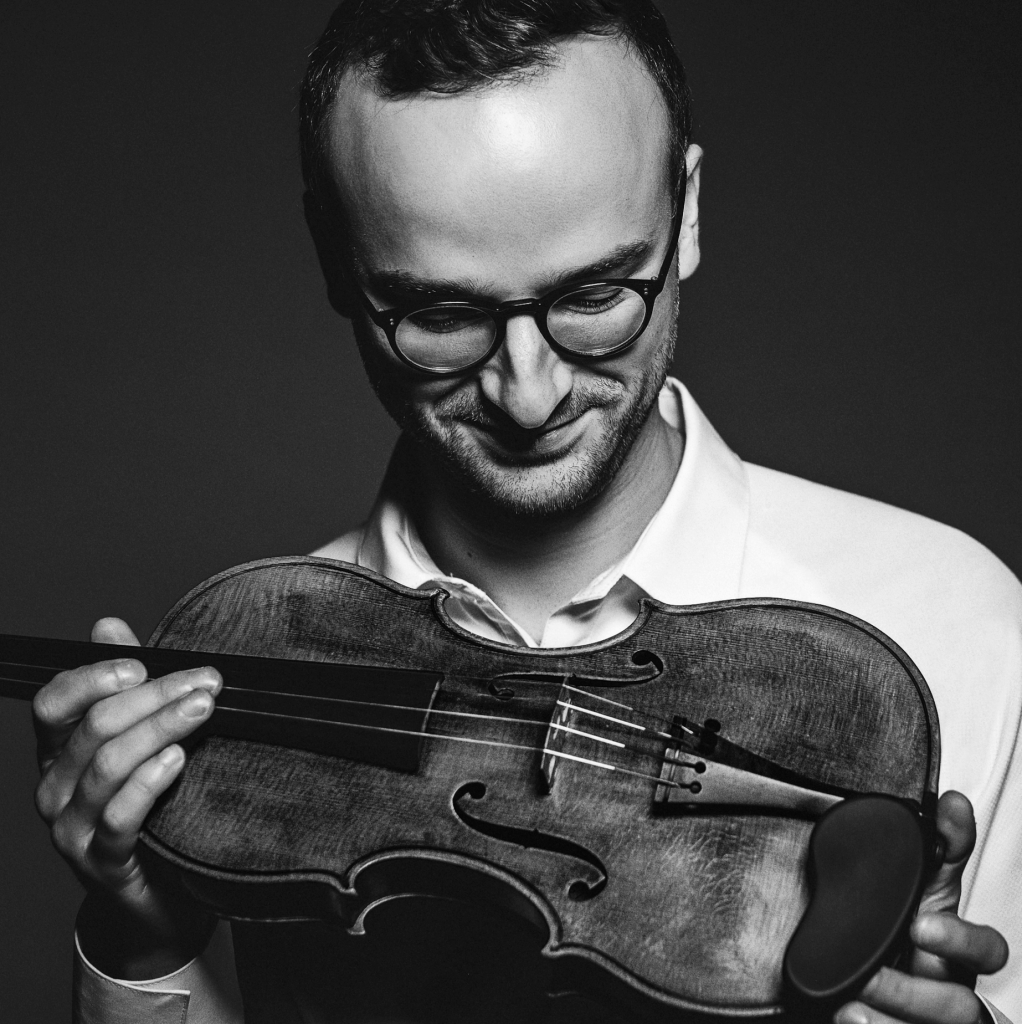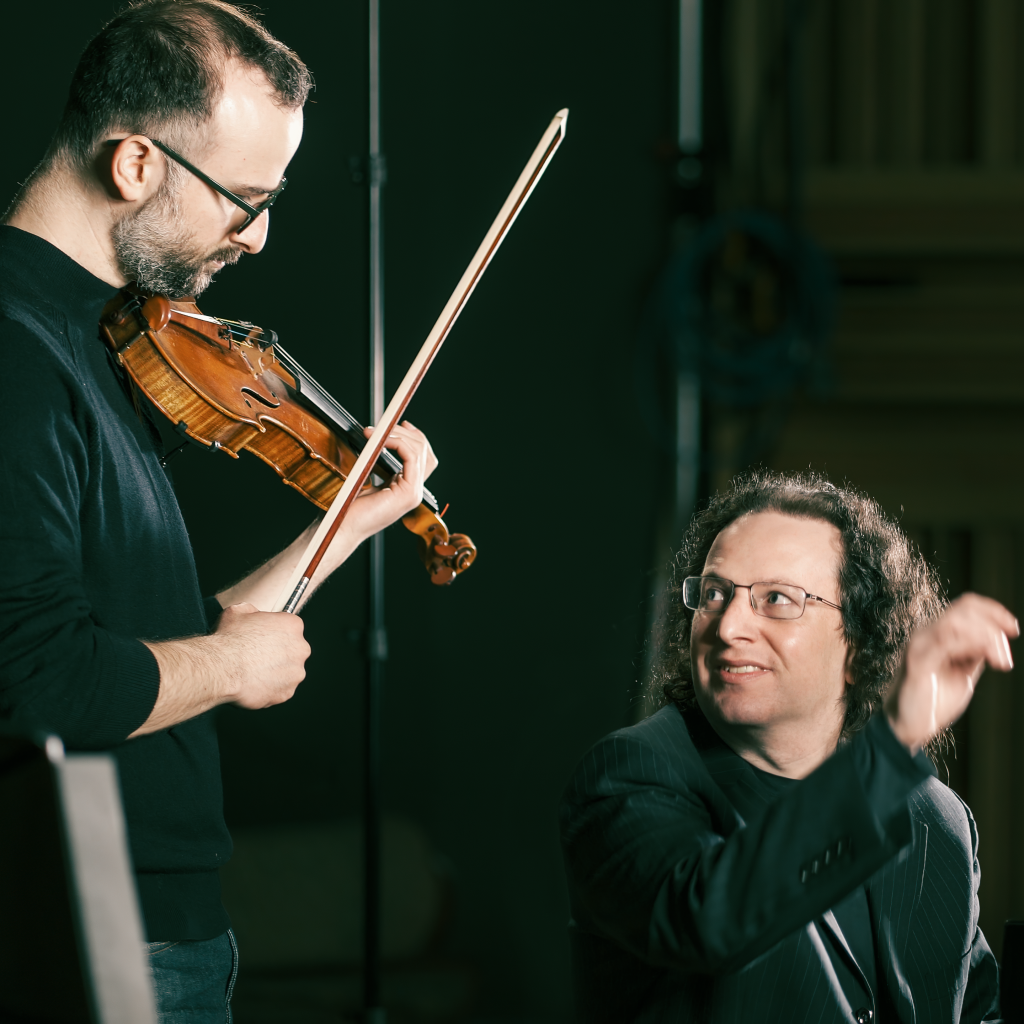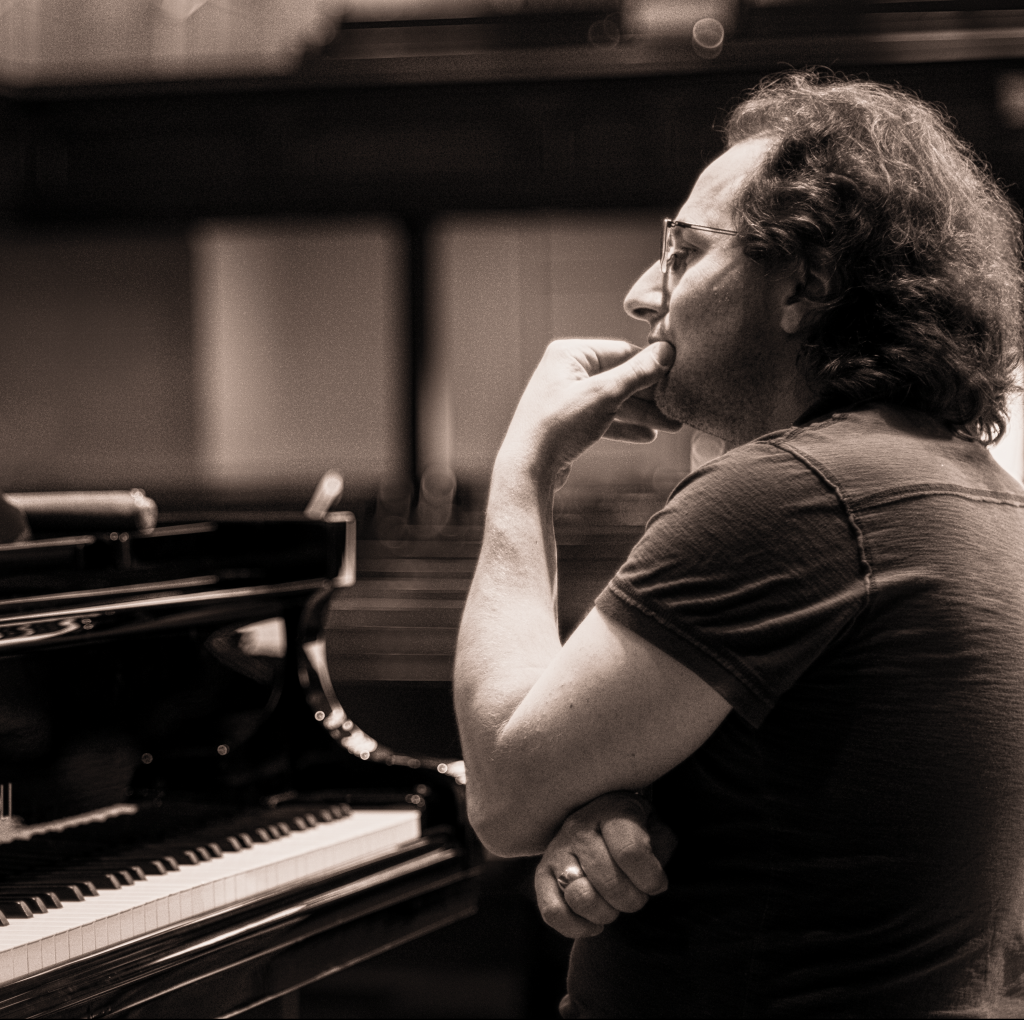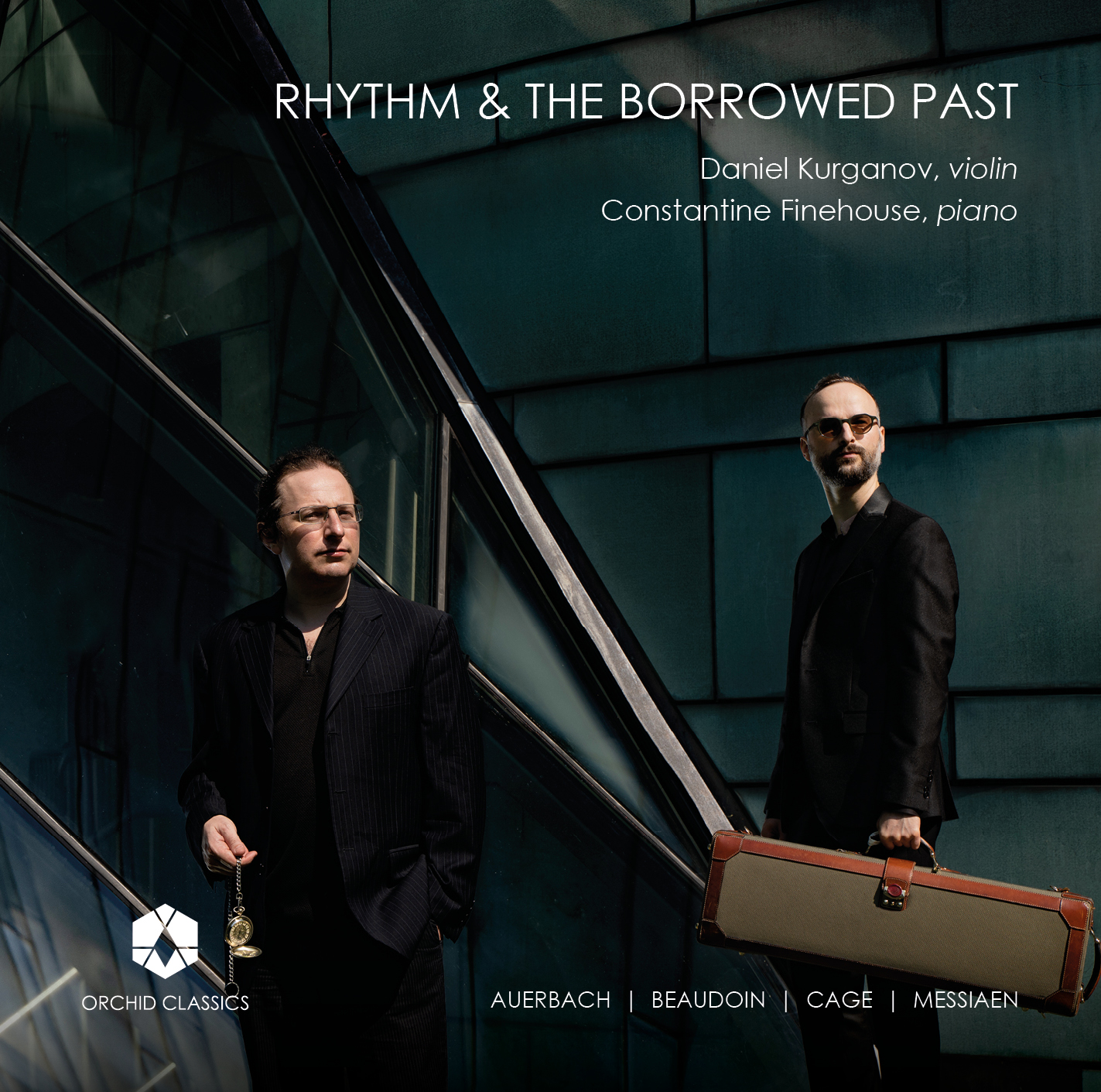Violinist Daniel Kurganov and pianist Constantine Finehouse present official world premiere recordings of 21st century works by Lera Auerbach and Richard Beaudoin, as well music by John Cage and Olivier Messiaen in an album of compositions that juxtapose the anguish of lost memories with openness and hope.



RHYTHM AND THE BORROWED PAST
Lera Auerbach (b.1973)
Sonata No.3 for violin and piano*
1. I Adagio tragico
2. II Allegro marcato
3. III Adagio pesante
4. IV Allegro assai
Commissioned by Arizona Friends of Chamber Music and the
Harry and Lea Gudelsky Foundation in memory of H. Paul Gudelsky
Richard Beaudoin (b.1975)
In höchster Not [In deepest need] for violin and piano*
5. I feroce, recitativo, moderato, grazioso, lento molto, agitato,
lento, recitativo, lento, animato misterioso
6. II poco maestoso, largo
7. III andante, più mosso, largo, prestissimo
John Cage (1912-1992)
8. Nocturne
Olivier Messiaen (1908-1992)
Thème et variations
9. Thème – Modéré
10. Variation I – Modéré (berceur)
11. Variation II – Modéré, un peu vif
12. Variation III – Modéré, avec éclat
13. Variation IV – Vif et passionné
14. Variation V – Très lent
Daniel Kurganov, violin
Constantine Finehouse, piano
*Official World Premiere Recording
I had a friend, a painter, who was once so immersed in the study of colour that, as he told it, he boarded a bus and experienced it chromatically. The bus itself, the people inside, and the landscape outside were not separate entities made of steel, glass, cloth, and bodies, but instead were fused into an interplay of light. Transpose the painter’s experience of color into the aural realm of rhythm, and you have a fascinating way to experience this recording of four works for violin and piano. Rhythm and duration – precisely how long everything lasts, from individual notes to phrases to movements – is a glorious differentiator between Olivier Messiaen’s Thème et variations, John Cage’s Nocturne for Violin and Piano, Lera Auerbach’s Sonata No. 3, and my duo In höchster Not. Some might roll their eyes: rhythm is important, of course, but what about melodies, explorations of timbre, chords? Keep these at bay: listen to Kurganov and Finehouse shape the duration of each sound, and you will be listening to the most alive aspect of these four works.
The rhythm of Messiaen’s Thème et variations (1932) is so continuously developmental – so controlled in its trajectory – that the listener is hardly aware of the variation structure. The theme is marked Modéré, and the first variation keeps this marking while exhibiting increased rhythmic fluidity. The second variation is marked Un peu moins Modéré, and the pulse moves from duple to triple time. The third is marked Modéré, avec éclat; the surface of the sound is embellished, and the individual measures subtly change duration: 2/4, 5/8, 3/4, and so on. The time shift into the fourth variation is so fluid as to pass by unnoticed. Messiaen marks this variation as Vif et passionné and the triple time is back. The fifth variation is a voluptuously harmonised and registrally extreme statement of the theme, now marked Très Modéré. While variations can become modular and uninteresting, Messiaen’s is expressive. In his hands, the entire form becomes a single rhythmic and experiential shape. Composed just after his marriage to the violinist Claire Delbos, Messiaen intended the work as a sort of wedding gift and gave the première alongside Delbos at a concert sponsored by the Cercle Musical de Paris on November 22, 1932.
Cage’s 1947 Nocturne for Violin and Piano was created by a thirty-five-year-old experimentalist, simultaneously at work on his Sonatas and Interludes for prepared piano, who still saw the usefulness of five-line staves and Italian tempo markings, such as the sempre rubato of the opening. Given the fluidity of the notation, existing recordings show a wide range of total duration, with some readings twice as long as others. I detect a strong French influence in the Nocturne’s rising and falling gestures, and I can’t help but smile when I hear Cage pull off a Janus-like juxtaposition: on the last page of the score, he quasi-quotes the closing of Debussy’s La fille aux cheveux de lin (1910), then immediately moves to a static and subtly shifting texture that foretells the Feldman of Palais de Mari (1986). The first performance of the Nocturne was given in New York on October 23, 1947, by the violinist Anahid Ajemian, one of the era’s greatest proponents of new music.
Lera Auerbach is a deliberate rhythmic thinker. At the macro scale, her Sonata No.3 (2005) is laid out in undisturbed blocks: adagio, allegro, adagio, allegro. At the micro scale, she prefers pulsed quarter- and half-note units in the slow movements, and steady-state repetitive figures in the fast ones. This is not a music of interruption; it follows through on its ideas and does so using the most elemental of musical objects. Her forms proceed as a series of inevitabilities, exhibiting great rhetorical and sonic power. The climactic measure in the sonata’s final movement plays out as eight emphatic, repeated quarter notes. Such an apotheosis is not generated through an increase in complexity, but by complexity’s dissolution. There is also an element of the theatrical: the elongated cadential gesture on the last page requires the violinist to manually de-tune the low G string to F, then E, and finally to D#, all while the piano tolls its lowest B. In this way, Auerbach dramatises the close of the sonata via the literal and figurative unwinding of both rhythm and pitch. The work was completed in December 2005 in Bremen. It was commissioned by Arizona Friends of Chamber Music in Tucson, Arizona, where it was premièred by violinist Stefan Milenkovich, with the composer at the piano.
Composed in the same year as Auerbach’s sonata, my violin and piano duo In höchster Not [In deepest need] is a student work whose teacher was Michael Finnissy. Finnissy’s best music transcribes the rhythmic fluidity of the real world, and my work at the time was reaching for similar things. Around the time of its composition, I was reading Cornell West’s The American Evasion of Philosophy, and the duo is marked by a constant evasion of stabilities, by escaping whatever it temporarily establishes (1). All three movements are contrapuntal: often, the piano is presenting a line whose cadences and highpoints refuse to coincide with those of the violin. Such an approach makes synchronicity rare. A meaningful exception occurs near the end of the last movement, where the arrival of the violin’s high C against the piano’s B major triad marks the only simultaneous attack in quite some time. In höchster Not was premiered in May 2005 in the nave of Christ Church Cathedral at Oxford University by my friends Jesse Holstein and Jeff Louie. Soon after, my music started to move away from evasion, and toward a different engagement with rhythm and borrowing: micro timing and millisecond-faithful transcriptions of iconic recordings.
Auerbach, Cage, Messiaen and I share a similar pre-occupation: the borrowing and refashioning of pre-existent material. While none of the pieces on this recording wear their quotations on the surface, each, in its own way, subsumes other music via distillation and digestion. For those who want to know more, studies of each composer’s respective methods include Jeff Perry’s 2021 article on Cage’s sketches (2), Kimberly Hain’s PhD on Auerbach’s use of Chopin (3), Danick Trottier’s articles on my micro-temporal transcriptions (4), and Yves Balmer, Thomas Lacôte, and Christopher Brent Murray’s magisterial work on Messiaen’s musical borrowing5.
In the summer of 2020, eighty-eight years after the premiere of Messiaen’s work, seventy-three years after Cage’s, and fifteen years after Auerbach’s sonata and my duo, Finehouse and Kurganov completed their recording of these four scores. Sharp turns, uncertainty, and sadness are all around — in the music and in the world — and something of that anxiety (that ‘need’) is reflected in their impressive and generous recordings.
© 2020 Richard Beaudoin. All rights reserved.
1 Cornel West, The American evasion of philosophy: a genealogy of pragmatism (Madison: University of Wisconsin Press, 1989).
2 Jeff Perry, “Cage’s Imitation Game: Cheap Imitation and Song Books through the Sketches,” Music Theory Online 27.3 (2021).
3 Kimberly Hain, “Lera Auerbach’s 24 Preludes For Violin and Piano, Op. 46: Unity and Musical Narrative,” Ph.D. dissertation, Florida State University (2010).
4 Danick Trottier, “Richard Beaudoin et la méthode du microminutage,” Dissonance 13 (2015); Danick Trottier, “Conceiving Musical Photorealism—An Interview with Richard Beaudoin,” Perspectives of New Music 51/1 (2013).
5 Yves Balmer, Thomas Lacôte, Christopher Brent Murray, foreword by George Benjamin, Le modèle et l’invention: Messiaen et la technique de l’emprunt (Paris: Symétrie, 2017).
____________________________________________
Richard Beaudoin (b.1975) has composed works for musicians including Claire Chase, Dashon Burton, Annette Dasch, Estelí Gomez, Annika Sophie Ritlewski, Constantine Finehouse, Mark Knoop, Wolfram Rieger, Ulrich Naudé, Frank Kelley, Kevin Burdette, Peter Sheppard Skaerved, Neil Heyde, and Rohan de Saram, and for ensembles and institutions including Roomful of Teeth, Boston Lyric Opera, Sound Icon, Konzerthaus Dortmund, and Staatstheater Kassel. His music has been heard in Europe at the Amsterdam Concertgebouw, Wiener Konzerthaus, Laeiszhalle Hamburg, Brucknerhaus Linz, Schwetzinger SWR Festspiele, in New York at The Kitchen and Weill Recital Hall, in Boston at Sanders Theatre and Jordan Hall, and in London at the Royal Festival Hall, Duke’s Hall, The Forge, The Arcola Theatre, Wilton’s Music Hall, Pushkin House, and King’s Place. He taught composition at Harvard University for eight years (2008–16), then held a Visiting Research Fellowship at the Royal Academy of Music, London. He is currently Assistant Professor of Music at Dartmouth College.
www.richardbeaudoin.com
A renaissance artist for modern times, Lera Auerbach (b.1973) is a widely recognised conductor, pianist, and composer. She is also a published poet and an exhibited visual artist. All her work is interconnected as part of a cohesive and comprehensive artistic worldview.
Born in the Russian city of Chelyabinsk in the Ural Mountains at the gateway of Siberia, Lera Auerbach has become one of today’s most sought after and exciting creative voices. Her performances and music are featured in the world’s leading stages – from Vienna’s Musikverein and London’s Royal Albert Hall to New York’s Carnegie Hall and Washington D.C.’s Kennedy Center.
Auerbach’s exquisitely crafted, emotional, and boldly imaginative music reached to global audiences. Orchestral collaborations include the New York Philharmonic, Philadelphia Orchestra, National Symphony, Oslo Philharmonic, Munich’s Bayerisches Staatsorchester, Staatskapelle Dresden, and Vienna’s ORF Radio-Symphonieorchester, among many others. Auerbach’s works for orchestra are performed by the world’s leading conductors, including Christoph Eschenbach, Alan Gilbert, Vladimir Fedoseyev, Neeme Järvi, Vladimir Jurowski, Charles Dutoit, Andris Nelsons, Osmo Vänskä, Hannu Lintu, and Marin Alsop, to mention only a few.
Her large-scale theatre works have been produced in major venues on every continent, including Vienna’s Theater an der Wien, New York’s Lincoln Center, the Hamburg State Opera, the War Memorial Opera House in San Francisco, the Royal Danish Theater, the Nuremberg State Theater, the Finnish National Theater, Moscow’s Stanislavsky, the National Centre for the Performing Arts in Beijing China and the NHK Hall in Tokyo.
Recent season highlights included WienModern’s 3.5-hour production of Demons & Angels with Auerbach as the conductor. Washington D.C.’s National Symphony premiered her 4th Symphony “Arctica” with Auerbach as piano soloist – a work commissioned by National Geographic Society alongside orchestras of the Arctic countries. Her 4th Violin Concerto NYx: Fractured Dreams” was commissioned and premiered by the New York Philharmonic with Alan Gilbert and Leonidas Kavakos, and the Vienna Radio Symphony Orchestra premiered her symphonic poem Eve’s Lament with Marin Alsop. Most recently, her String Quartet No.9 “Danksagung” was premiered by the Artemis Quartet as a commission of Leipzig’s Gewandhaus, London’s Wigmore Hall London, Vienna’s Konzerthaus, New York’s Carnegie Hall, and Tonhalle Zürich.
Her music is championed and recorded by today’s most prominent classical performers including violinists Gidon Kremer, Leonidas Kavakos, Daniel Hope, Hilary Hahn, Vadim Gluzman, Vadim Repin, Julian Rachlin; cellists Alisa Weilerstein, Gautier Capuçon, Alban Gerhardt, David Finckel; violists Kim Kashkashian, Nobuko Imai, and Lawrence Power, and many others.
Auerbach is equally prolific in literature and the visual arts. She incorporates these forms into her professional creative process, often simultaneously expressing ideas visually, in words, and through music. She has published three books of poetry in Russian, and her first English-language book, Excess of Being – in which she explores the rare form of aphorisms. Her next book, an illustrated work for children, A is for Oboe, will be published by Penguin Random House in the fall of 2021. Auerbach has been drawing and painting all her life as part of her creative process. Her visual art is exhibited regularly, included in private collections, and is represented by leading galleries.
Lera Auerbach holds multiple degrees from the Juilliard School in New York and Hannover University of Music, Drama, and Media in Germany. The World Economic Forum in Davos, Switzerland, selected her in 2007 as a Young Global Leader and since 2014 she serves as a Cultural Leader. Internationale Musikverlage Hans Sikorski publishes her work, and recordings are available on Deutsche Grammophon, Nonesuch, Alpha Classics, BIS, Cedille, and many other labels.
www.leraauerbach.com
Olivier Messiaen (1908–1992) was a French composer, organist, and ornithologist, one of the major composers of the 20th century. His music is rhythmically complex; harmonically and melodically he employs a system he called modes of limited transposition, which he abstracted from the systems of material generated by his early compositions and improvisations. He wrote music for chamber ensembles and orchestra, vocal music, as well as for solo organ and piano, and also experimented with the use of novel electronic instruments developed in Europe during his lifetime.
He travelled widely and wrote works inspired by diverse influences ranging from Japanese music, the landscape of Bryce Canyon in Utah and the life of St. Francis of Assisi. He said he perceived colours when he heard certain musical chords (a phenomenon known as synaesthesia in its literal manifestation); combinations of these colours, he said, were important in his compositional process. For a short period, Messiaen experimented with the parametrisation associated with “total serialism”, in which field he is often cited as an innovator. His style absorbed many global musical influences such as Indonesian gamelan (tuned percussion often features prominently in his orchestral works).
Messiaen entered the Paris Conservatoire at the age of 11 and was taught by Paul Dukas, Maurice Emmanuel, Charles-Marie Widor and Marcel Dupré, among others. He was appointed organist at the Église de la Sainte-Trinité, Paris, in 1931, a post held for 61 years until his death. He taught at the Schola Cantorum de Paris during the 1930s. On the fall of France in 1940, Messiaen was made a prisoner of war, during which time he composed his Quatuor pour la fin du temps (“Quartet for the end of time”) for the four available instruments – piano, violin, cello and clarinet. The piece was first performed by Messiaen and fellow prisoners for an audience of inmates and prison guards. He was appointed Professor of Harmony soon after his release in 1941, and Professor of Composition in 1966 at the Paris Conservatoire, positions he held until his retirement in 1978. His many distinguished pupils included Iannis Xenakis, George Benjamin, Alexander Goehr, Pierre Boulez, Tristan Murail, Karlheinz Stockhausen, Myung-whun Chung and Yvonne Loriod, who became his second wife.
He found birdsong fascinating, notating bird songs worldwide and incorporating birdsong transcriptions into his music. His innovative use of colour, his conception of the relationship between time and music, and his use of birdsong are among the features that make Messiaen’s music distinctive.
John Cage (1912–1992) was an American composer, music theorist, artist, and philosopher. A pioneer of indeterminacy in music, electroacoustic music, and non-standard use of musical instruments, Cage was one of the leading figures of the post-war avant-garde. Critics have lauded him as one of the most influential composers of the 20th century. He was also instrumental in the development of modern dance, mostly through his association with choreographer Merce Cunningham, who was also Cage’s romantic partner for most of their lives.
Cage is perhaps best known for his 1952 composition 4′33″, which is performed in the absence of deliberate sound; musicians who present the work do nothing aside from being present for the duration specified by the title. The content of the composition is not “four minutes and 33 seconds of silence,” as is often assumed, but rather the sounds of the environment heard by the audience during performance. The work’s challenge to assumed definitions about musicianship and musical experience made it a popular and controversial topic both in musicology and the broader aesthetics of art and performance. Cage was also a pioneer of the prepared piano (a piano with its sound altered by objects placed between or on its strings or hammers), for which he wrote numerous dance-related works and a few concert pieces. The best known of these is Sonatas and Interludes (1946–48).
His teachers included Henry Cowell (1933) and Arnold Schoenberg (1933–35), both known for their radical innovations in music, but Cage’s major influences lay in various East and South Asian cultures. Through his studies of Indian philosophy and Zen Buddhism in the late 1940s, Cage came to the idea of aleatoric or chance-controlled music, which he started composing in 1951. The I Ching, an ancient Chinese classic text decision-making tool, which uses chance operations to suggest answers to questions one may pose, became Cage’s standard composition tool for the rest of his life. In a 1957 lecture, Experimental Music, he described music as “a purposeless play” which is “an affirmation of life – not an attempt to bring order out of chaos nor to suggest improvements in creation, but simply a way of waking up to the very life we’re living”.
Soviet-born American Violinist Daniel Kurganov and Russian-American pianist Constantine Finehouse perform a stunning programme of contemporary and 20th-century music by Lera Auerbach, Richard Beaudoin, John Cage and Olivier Messiaen.
As Richard Beaudoin argues in his booklet notes, this programme is characterised by the powerful sense of rhythm shared by these composers and the performers themselves.
Russian polymath Lera Auerbach uses rhythm in a rhetorical and unifying way in her dramatic Violin Sonata No. 3 (2005). Richard Beaudoin composed In höchster Not (‘In deepest need’) when he was a student of Michael Finnissy; during the work’s three contrapuntal movements the violin and piano are often independent, even out-of-sync. John Cage is known for his witty avant-garde experiments in sound and his Nocturne (1947) is written in fluid notation, allowing the performers considerable freedom in their interpretation so that every performance is truly unique. Olivier Messiaen’s rhythms were influenced by Indian music and are combined in his Thème et variations (1932), as with all his music, with a vivid sense of colour.
Daniel Kurganov
Violin
“Kurganov’s violin empowered with penetrating colors and expert
phrase shapes…”
The Boston Musical Intelligencer
Soviet-born American Violinist Daniel Kurganov has been described as a musician of “smoldering intensity” and “ingratiatingly idiomatic violinistic personality” (Fanfare Magazine). Synthesising values of different artistic traditions, Daniel has emerged as a unique musical voice. He has already garnered praise from such musical giants as Sergej Krylov, Ivry Gitlis and Rudolf Koelman, as well as from publications in the United States, Europe and Japan. 2018 saw his debut album release with pianist Constantine Finehouse on the Spice Classics label. The album, featuring masterworks of Brahms, Prokofiev, Tchaikovsky, and others, was met with positive reviews. Recent seasons have included concerts at Merkin Hall (NYC), BargeMusic (NYC), Roerich Museum (NYC), Museum of Fine Arts (Boston), Harvard Musical Association, and a tour of Japan. In Sion, Switzerland, he was invited to perform on a violin rescued from Auschwitz for the Violins of Hope project. A passionate teacher, Daniel founded the Boston Violin Intensive and runs an educational YouTube channel with over 35,000 subscribers and 10+ million viewers. Upcoming album releases include the complete Brahms Violin Sonatas with pianist Constantine Finehouse, which pairs a 17th-c Guarneri violin with an original 19th-c Streicher piano. Born in Minsk, Kurganov grew up near Chicago and began his musical studies on the piano. He completed his studies at the Zurich University of the Arts (ZHdK) under Rudolf Koelman, protégé of Jascha Heifetz. Kurganov is also an alumnus of the Keshet Eilon International Mastercourse.
www.kurganov.org
Constantine Finehouse
Piano
“…interpretations of depth and maturity.”
Rhein Main Presse Allgemeine Zeitung
Pianist Constantine Finehouse has performed extensively in the US and abroad, including in Salzburg, Trieste, London, St. Petersburg and Odessa. His recent album with cellist Sebastian Baverstäm features music by Brahms and Boston composer Tony Schemmer. His 2009 solo release, “Backwards Glance,” interweaves works by Brahms and Richard Beaudoin. “The Bolcom Project,” made in collaboration with his American Double partner, violinist Philip Ficsor, included an Albany Records two-CD album and a national tour with concerts in Boston, New York, Denver, Santa Barbara, Spokane and at Yale University. Fanfare praised the recording as “indispensable to any serious collector with an interest in later 20th-century duo repertoire for violin and piano.” The American and European premieres of William Bolcom’s Horn Trio, in collaboration with Ficsor and Steven Gross, took place in the summer and fall of 2018. The work, commissioned by the group, was recently recorded at the Martinu Hall in Prague for an upcoming release on Naxos. Additionally, Finehouse recorded Bolcom’s piano solo works for Naxos in 2017, and an album with violinist Daniel Kurganov for Spice Classics in 2018. During the recent seasons Finehouse has performed at the Mozarteum (Salzburg), Miaskovsky Hall (Moscow Conservatory), Merkin Recital Hall (NYC), Weill Recital Hall (Carnegie Hall) and Jordan Hall (Boston), as well as at Harvard, Yale, and Emory universities, and St. Vincent’s and Elmira colleges, among others. With degrees from Juilliard and Yale, Finehouse teaches at New England Conservatory and serves as Visiting Artist/Faculty at Westmont College, CA.

Click the button above to download all album assets.

